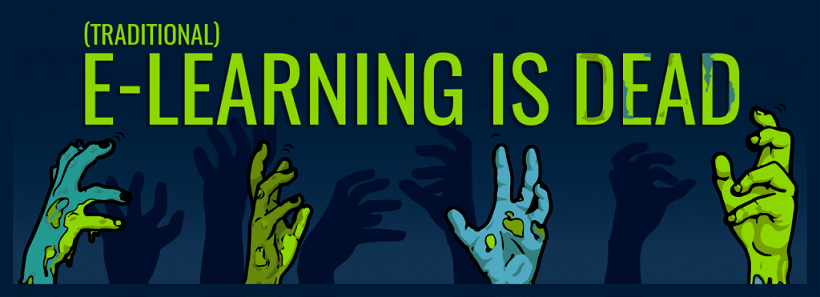Why Traditional eLearning Is Dead And What Needs Be Done
I recently attended Learning Technologies, one of the largest training conventions in the world. I delivered a seminar on a topic that’s very close to my heart. I believe that the traditional method of training delivery is inefficient, it doesn’t fit the way people learn, and it just doesn’t work anymore. I’m not the only one who thinks learning technology is too set in its ways – according to a recent report by Deloitte1, the Learning Management System market is set to drop from $46.6 billion last year to $33.4 billion by 2021 due to lack of innovation. Traditional eLearning is dead. The traditional methods are gone, kaput, expired – eLearning is an ex-parrot! My conviction is so strong that I simply had to wear a superhero cape… and brandish a gigantic, pink BlandBlaster while making the presentation! Just in case you couldn’t attend, let me give you, the intrepid eLearning Industry reader, a quick run-down.
Learning Is A Journey... Not A Destination
As I mentioned, traditional eLearning has been broken for a long time and it’s down to us, the learning community, to replace it with something better. The problem is that it’s based on a false premise: The assumption that one-off learning events are effective.
According to Ebbenhaus’ Forgetting Curve, we can lose up to 90% of learning within a week of a training intervention2. The only way to combat this knowledge loss is to reinforce the training at regular intervals. This shouldn’t come as a surprise if you’ve ever tried to learn anything. You don’t simply go to the learning store and pick up some knowledge – it takes time, effort, and perseverance. Learning is and always has been a journey, not a destination.
Back To Basics: What’s The Goal?
As a training manager, why do you get up in the morning? Do you live to push out assessments and run reports every week, or do you have a deeper, more meaningful purpose? The goal in any learning intervention isn’t to deliver an eLearning unit – it’s to make sure that everything you do inspires lasting behavior change.
If the training improves knowledge for a while, that’s a good start, but knowledge on its own doesn’t have a lot of value. It’s how the learners interpret that knowledge and use it to better serve the aims of the business that’ll make a real difference. If you want to see a measurable return on the training investment, you can’t afford to waste time with obsolete training methods that don’t impact behavior.
The Challenge Of Behavior Change
If changing behavior was easy, you wouldn’t be reading this. You’d already have an enthusiastic and committed workforce pulling together to get your business to the top! The easy part is transferring knowledge and giving people the tools they need to perform.
If we consider Bloom’s Taxonomy, a framework for categorizing educational goals, the challenge of behavior change is easier to understand. The framework plots the learning journey from start to end. At the beginning, the teacher is only concerned with imparting knowledge. All the student needs to do is be able to repeat what they’ve learned.

As they progress along the stages of learning, the students are given more challenging tasks, from interpreting the knowledge in their own words, to applying the knowledge in a practical way. The main problem with the traditional eLearning approach is that it relies on massive information dumps. These really only deal with the early stages of Bloom’s Taxonomy. They don’t offer a mechanism for guiding people further along the learning journey.
How Can You Change Behavior? 5 Elements Training Of The Future Needs To Have
So, we’ve established that behavior change should be goal for any learning intervention – what now? The scary fact is that Learning and Development managers need to completely rethink their approach to training and embark on a learning journey of their own. They need a solution that focuses on the learners themselves – what they want, how they behave and what they can contribute.
To sum it up, the learning solution of the future needs to tick the following boxes:
1. It Needs To Be Fun.
If your learners don’t enjoy the experience, it won’t leave much of a mark. At best, they’ll forget about it – but in all likelihood, they won’t even complete it. There are thousands of other, more engaging things that they could be doing rather than slogging through something that bores them. Dull eLearning is just not worth their time.
2. It Needs To Be Bitesized.
Speaking of time, nobody has very much of it today. Because we’re living in an age of instant-access information, people don’t have the attention spans they used to. In fact, as of 2015, it’s as little as 8 seconds, which is even less than a goldfish3!
3. It Needs To Be Mobile.
If you’re not delivering your training on a mobile device, most of your learners aren’t going to see it. In 2016, mobile usage overtook desktop usage for the first time4 and that’s a trend that’s set to continue. At the very least, you should make sure that your Learning Management System is mobile responsive, but even then, the content might not be a good fit. Ideally, you should invest in a designated mobile learning platform.
4. It Needs To Be Campaign-Driven.
In an earlier article, I compared a training manager’s job with that of a marketer. Marketers are focused on hooking an individual’s attention and driving them towards a conversion. This doesn’t happen in a one-off event, rather it’s a campaign that’s delivered over a period of time – and it works! Learning interventions need to be created in the same way if they’re going to get similar results.
5. It Needs To Be Social.
Finally, it’s important to remember that your formal eLearning content will only ever amount to 10% of what your people learn at work. A truly effective solution needs to have a social element in order to capitalize on the informal learning that happens all the time. Also, because your learners influence each other, this social interaction acts as a bridge between learning and behavior.
Final Word
As more and more training professionals wake up to the fact that their old habits don’t work anymore, the face of training is changing for the better. There are new, more exciting technologies on the horizon that adapt to the way people learn today. If you want to dig a little deeper, visit this link to check out the rest of my presentation. A video will also be available shortly, so be sure to subscribe to the Growth Engineering blog and you’ll be the first to know about it!
Footnotes:
- Global Human Capital Trends 2016
- Brain Science: The Forgetting Curve–the Dirty Secret of Corporate Training
- Humans have shorter attention span than goldfish, thanks to smartphones
- Mobile web usage overtakes desktop for first time










